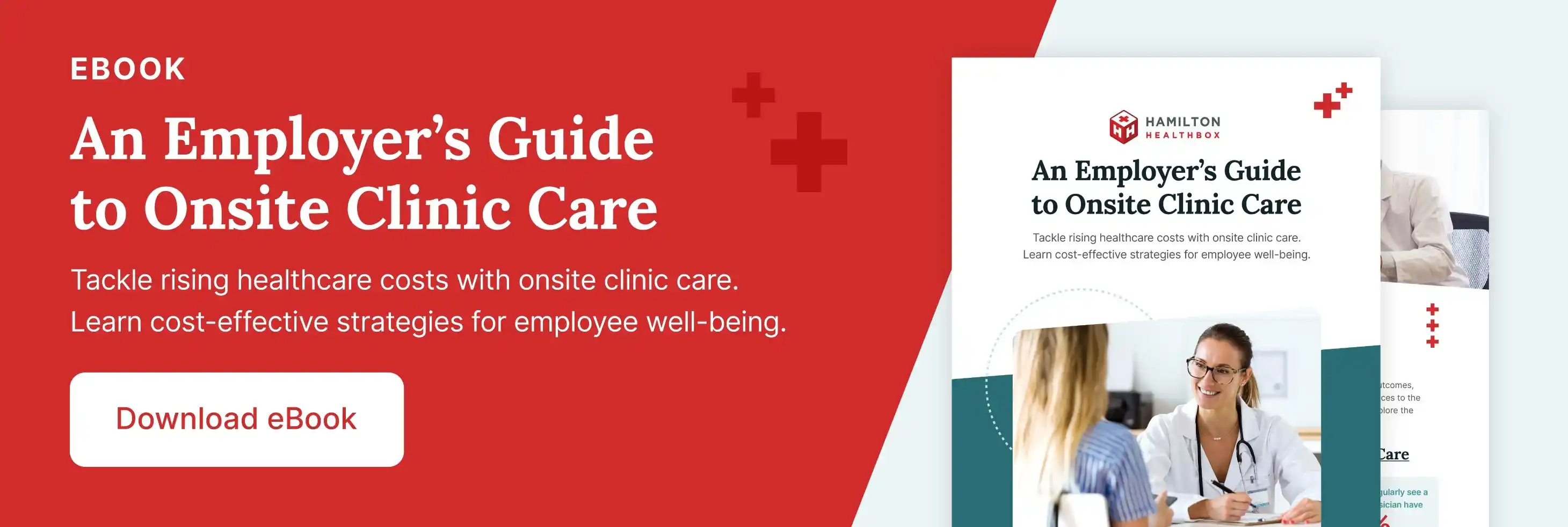
Many American workers struggle to access primary healthcare. To address this problem, an increasing number of employers are turning to onsite care programs. In fact, according to a 2021 survey conducted by the National Association of Worksite Health Centers (NAWHC) and Mercer, 33% of organizations with at least 5,000 employees offer a primary care clinic to their workers. For employers with 20,000 or more employees, that number rises to 38%. Until now, only large employers could afford onsite clinic programs, but today solutions exist for employers with as few as 150 employees.
But what exactly is an onsite clinic? NAWHC defines it as a “setting where an employer or union offers one or more medical and wellness services, delivered by licensed providers, to all or a designated portion of its active population and other eligible individuals.” Also referred to as “wellness centers,” onsite clinics originally began as occupational health centers where workers could be treated for minor injuries that occurred on the job. Today, they have expanded into providing primary care and other services.
Benefits of Onsite Clinics: Removing Barriers to Healthcare Access and More
OOnsite care offers several important benefits for employers and their employees. According to NAWHC, these include:
-
Convenient Access.
Because of the proximity of onsite clinics, employees are more likely to seek preventive screenings, immunizations, and services that they might not otherwise receive. This removes barriers to healthcare access that employees may have otherwise faced. Reduced time away from work to travel to physicians’ offices also increases employee productivity.
-
Reduced Cost.
As a result of using primary care services, employees will reduce the use and associated costs of emergency room or urgent care visits, which are extremely expensive.
-
Improved Retention.
Onsite clinics are an investment that businesses make to ensure the well-being of their employees, which can go a long way to attracting and retaining high-quality talent.
Is an Employer Onsite Health Clinic a Fit for Your Business?
Although not all organizations can support onsite clinics, for many employers, they are a realistic and effective option. Consider the following when determining whether your company is a good fit for an onsite clinic:
-
Size: Past perceptions held that only large corporations could afford to offer onsite care.
But that is simply not true. Firms with as few as 150 employees can successfully implement wellness and primary care programs. Smaller organizations can benefit from part-time clinic programs. In a 2021 survey, among organizations that provide onsite care with fewer than 5,000 employees, 47% offered a shared clinic, compared to just 7% of those with 5,000 or more employees
-
Employee Population: Do your employees neglect primary care, seek treatment at the emergency department, or have high absentee rates?
An onsite clinic can directly address all of those issues by providing preventive services that are convenient, accessible and cost-effective. Clients of onsite service provider Healthbox™ have seen a 37% increase in annual physicals, a 43% drop in ER and urgent care visits, and a 46% increase in primary care visits.
-
Insurance Model: Fully-funded and self-funded insurance models are both able to support onsite care programs.
However, because of the high level of risk employers assume, self-funded programs are especially well-positioned to benefit. By providing healthcare services in the workplace, employers offering self-funded insurance may see lowered and more predictable total costs of care. Healthbox™ can work with most benefits plan types including PPOs, EPOs, HDHP/HSAs, and even uninsured employees and their families.
-
Geographic Characteristics: Location can be a barrier to healthcare access for organizations in remote or rural communities.
A lack of primary care providers in a particular area also creates challenges for employees. But through onsite programs, employers can extend healthcare access to their employees in markets that lack dependable preventive care services. Some programs, like Healthbox™’s model, offer 24/7 virtual urgent care, which extends coverage to employees regardless of their location.
Tips for Successfully Implementing Onsite Healthcare
A foundation of high-quality care goes a long way to creating and retaining healthier, happier employees and controlling the total cost of care. To reach that goal, consider the following in your strategy for implementing an onsite care program:
-
Provide Employer Health Incentive Programs.
Offering employees financial incentives can encourage onsite care utilization. The most common incentives include:
- Eliminating employees’ co-payments.
- Reducing the dollar amount of co-payments.
- Decreasing employees’ premium contributions.
- Offering the clinic as a plan option.
- Contributing to employees’ HSA accounts.
- Providing cash or gift cards.
Many times, employer health incentive programs are linked to wellness goals that must be reached first, such as obtaining biometric screenings or attending health coach visits. These are also ways to bring employees into the clinic for the first time and begin to create relationships with onsite providers.
The location of the health clinic can also impact utilization. Employees are more likely to visit an onsite clinic based on its accessibility and visibility as well as the privacy and professionalism it provides. However, some employers may lack the space to establish a permanent onsite clinic. Fortunately, companies like Healthbox™ offer mobile solutions in which medical staff establish temporary clinics in unused conference rooms or offices. In these scenarios, patients receive high-quality care that is delivered with current technology—and in a convenient setting.
-
Design the Right Service Mix.
Onsite care fulfills its promise when services are tailored to the specific needs of workers. Thus, a critical first step is to gather information and identify perceived gaps in employee physical and mental healthcare by seeking feedback—then designing your program around that data.
For example, mental health in the workplace is a rising concern for employers and employees alike. In a 2021 survey, the American Psychological Association (APA) found that 32% of respondents believed that work stress led to feelings of emotional exhaustion; three in five respondents said that this stress impacted their motivation, energy, and effort levels at work. If you determine that your employees want mental health services as part of the organization’s wellness program, dig deeper to discover exactly what your employees want those services to look like. Do they want access to meditation apps, telephone and video appointments, and/or digital self-help tools?
-
Make Care Convenient.
Employee engagement is critical to the success of onsite care programs, and convenience makes that engagement easier to secure. Be sure your organization offers:
- Walk-ins or online appointment scheduling.
- Health information, such as test results, and appointment summaries.
- Onsite testing for flu, COVID, strep, etc.
- Onsite blood draws for labs.
- Messaging opportunities with providers.
- Personalized, meaningful action tools and resources.
Virtual care, or telehealth, is playing an increasingly important role in the delivery of primary healthcare services. According to the Journal of Primary Care & Community Health, the percentage of primary care physicians using telehealth grew from 5.3% before the COVID-19 pandemic to 46.2% during the pandemic. Furthermore, more than 70% of physicians participating in the study stated that they intended to use telehealth after the pandemic, compared to just 18.7% before.
Virtual care is just as important in the onsite setting. Blending the personalization of onsite clinics with the convenience of telehealth gives employers opportunities to increase the amount and type of care available to employees. Results of a recent survey conducted by the Business Group on Health anticipate growth in the virtual primary care offered by employers from 32% in 2022 to 69% in 2025. Furthermore, 57% of employers plan to add even more virtual health solutions in 2023.
Get Support for Building an Onsite Healthcare Plan
If onsite care sounds like an effective way to create a healthy and happy employee population while managing costs for everyone, Healthbox™ staff can recommend onsite care approaches to best meet your needs. We provide a unique hybrid approach of in-person and telehealth services and work with employers to determine the service mix and onsite availability that is right-sized for employers’ populations. Find out more about how we can help you build an onsite care plan that’s aligned with the needs of your business: Book a 1:1 meeting today!


